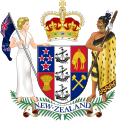- Electoral system of New Zealand
-
New Zealand 
This article is part of the series:
Politics and government of
New ZealandConstitution General
In 1994 New Zealand officially adopted mixed member proportional representation (MMP) as its electoral system for the House of Representatives after many years of first-past-the-post voting. The first MMP election was held in 1996.
The term of the Parliament is set at three years from its first sitting. This means that an election must be held within approximately three years and two months of the previous election (for instance the 2002 election was held on 27 July, the latest date the 2005 election could be held on was 24 September). Elections are traditionally held between October and December, but snap elections in 1984 and 2002 caused some of the following elections to be held earlier.
Contents
MMP in New Zealand
The New Zealand electoral system is a two-tiered house. The lower tier determines the local representative. The upper, over-riding tier determines the proportionality of the House.
New Zealand voters have two votes. The main vote is the party vote. This vote determines the proportionality of the House, the upper tier of the electoral system. The other vote is the electorate vote for the lower tier. This determines the local representative within the House, and usually does not change the proportionality of the House. The electorate vote works as a plurality system, whereby whichever candidate gets the highest electorate vote in each electorate receives the seat. Since the two votes do not need to be for the same party, voters can punish or reward local candidates. In the 2005 election 20% of local representatives elected were of a party other than the party which got the largest party vote in that electorate.
Parties that receive 5% or more of the party vote are entitled to a share of the nominally 120 seats in the House of Representatives. Likewise parties that win one or more electorate seats – a rule that applied to four parties that polled below the 5% threshold in 2005, although only two of the four qualified for additional list seats. The seats are allocated using the Sainte-Laguë method. If any independent candidates are elected, the number of seats to be allocated falls by the number of independent representatives, for example, 118 seats are allocated if two independents are elected.
Parties then fill their seats. Seats are allocated first to electorate MPs. Then parties fulfil their remaining quota from their party list. If a party has more electorate MPs than proportional seats, then it receives an overhang. If the party does not have enough people on its list to fulfil its quota, then there is an underhang.
There will be a referendum at the 2011 general election on whether MMP should be retained.
Electoral boundaries
The number of electorate MPs is calculated in three steps. The less populated of New Zealand's two principal islands, the South Island, has a fixed quota of 16 seats. The number of seats for the North Island and the number of special reserved seats for Māori are then calculated in proportion to these. (The Māori seats have their own special electoral roll; people of Māori descent may opt to enroll either on this roll or on the general roll, and the number of Māori seats is determined with reference to the number of adult Māori who opt for the Māori roll.)
The number of electorates is recalculated, and the boundaries of each redrawn so as to make them approximately equal in population within a tolerance of plus or minus 5%, after each quinquennial census. After the 2001 census, there were 7 Māori electorates and 62 general electorates, or 69 electorates in total. There were therefore normally 51 list MPs. By a quirk of timing, the 2005 election was the first election since 1996 at which the electorates were not redrawn since the previous election. A census was held on 7 March 2006 and new electorate boundaries released on 25 September 2007, creating an additional electorate in the North Island.[1] For the election in 2011 there will be 63 general electorates, 7 Māori electorates and 50 list seats.
Representation statistics
The Gallagher Index is a measurement of how closely the proportions of votes cast for each party is reflected in the number of parliamentary seats gained by that party. The resultant disproportionality figure is a percentage - the lower the index, the better the match.[2]
Election Disproportionality 1946-1993 FPP average 11.10% 1996 4.36% 1999 3.01% 2002 2.53% 2005 1.11% The Gallagher index on the provisional election night figures for the 2008 election is 4.06
See also
- Electoral reform in New Zealand
- History of voting in New Zealand
- New Zealand elections
References
- ^ Trevett, Claire (26 September 2007). "Central North Island marginal". The New Zealand Herald. http://www.nzherald.co.nz/topic/story.cfm?c_id=144&objectid=10465936. Retrieved 29 September 2011.
- ^ Stephen Levine and Nigel S. Roberts, The Baubles of Office: The New Zealand General Election of 2005 (Wellington: Victoria University Press, 2007), pp.33-4 ISBN 978-0-86473-539-3
External links
Categories:- Elections in New Zealand
- Politics of New Zealand
- Constitution of New Zealand
- Electoral systems by country
Wikimedia Foundation. 2010.



